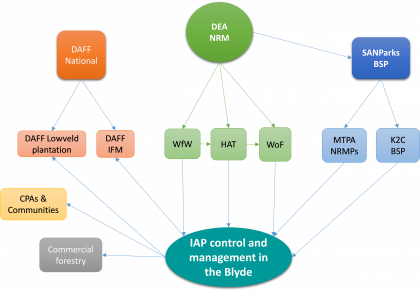
Restoring and maintaining healthy ecosystems
The Blyde area is renowned for its biodiversity and has been the focus of numerous initiatives and considerable investment to clear alien vegetation and improve water flows. It is, however, still threatened by invasive alien plant species (IAP) and soil erosion, particularly associated with timber plantations.
The objective of the Blyde Restoration project, run in collaboration with Kruger to Canyons Biosphere Region NPC (K2C), is to support the restoration of degraded ecosystems, and the maintenance of these and adjoining healthy ecosystems in the upper Blyde and adjacent upper Klaserie catchments, by key roleplayers, in order to sustain biodiversity and ecosystem services in this high priority area in the long term. We aim to support the development of coordinated and integrated restoration and IAP control efforts both in the short and long term by natural resource and biodiversity management agencies working in the upper Blyde and upper Klaserie Catchments.
We seek to do this by focusing on collaborative strategic planning and action and skills development, new clearing approaches and better institutional arrangements. Dialogues on climate change and adaptation strategies are also an important part of this project.

Our main activities:
- collaborative development and implementation of a joint strategic plan for long term, coordinated and integrated restoration;
- capacity development of practitioners on key skills within the restoration practice;
- collaborative development of new IAP control methodologies and approaches;
- enhanced collective action and development of tenable and appropriate institutional arrangements
The Blyde Restoration Group, initiated through RESILIM-O and coordinated by AWARD and K2C, has proven a very effective “space” for social learning and collective agency. Key partners include Department of Environmental Affairs (DEA) Natural Resource Management Programmes (NRMPs), including Working for Water, High Altitude Teams (HAT), and Working on Fire, as well as the Mpumalanga Tourism and Parks Agency, the Kruger-to-Canyons Biosphere NPO (K2C), the Department of Agriculture Forestry & Fisheries, and SANParks, and convened by AWARD.
Areas of collaboration secured through AWARD facilitation:
- an invasive species inventory map,
- a management plan for the Blyde Nature Reserve,
- a plan for clearing inaccessible areas in the Blyde Canyon,
- a restoration strategy for the Lowveld Plantations,
- a streamflow monitoring plan,
- wetland assessments
- a timber biomass assessment, and
- securing additional funding to support this work

